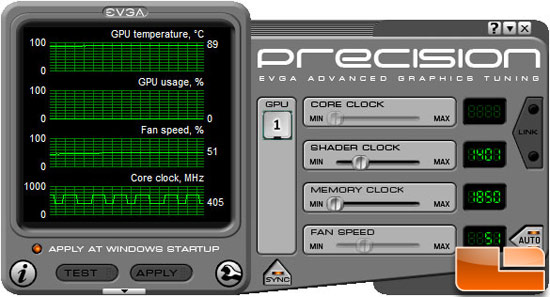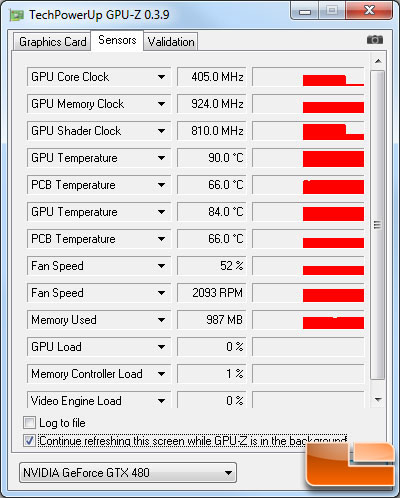NVIDIA GeForce GTX 480 GF100 DX11 Video Card Review
Dual LCD Display Testing
For years I have used a dual monitor setup in the office as it makes life easier and you honestly do become more productive when doing the daily tasks. When I first got the NVIDIA GeForce GTX 480 reference card I stuck it into the office system as I was curious how it would perform in my main system. Yes, I actually spent a few days with this card leaving it powered on 24/7 for a little longer than a 3-day stint to see what it would be like in a system like any of our readers would own. The card worked great in Adobe Photoshop CS4 and all the other GPU accelerated applications I use on a daily basis, but sadly it doesn’t have a working F@H GPU client available for it. The day after I initially installed the GeForce GTX 480 graphics card in my system I noticed that my office was much hotter than any room in my house and I knew the graphics card was to blame.

I fired up EVGA Precision and instantly two things jumped out at me. The first is that the GPU was idling around 89-90C and the second is that the core clock of the GPU looked to be pulsing at a regular cycle.

After a little more a little more investigation I discovered that the GeForce GTX 480 video card was sitting at 90C in an idle state since I had two monitors installed on my system. I talked with some of the NVIDIA engineers about this ‘issue’ I was having and found that it wasn’t really an issue per say as they do it to prevent screen flickering. This is what NVIDIA said in response to our questions:
“We are currently keeping memory clock high to avoid some screen flicker when changing power states, so for now we are running higher idle power in dual-screen setups. Not sure when/if this will be changed. Also note we’re trading off temps for acoustic quality at idle. We could ratchet down the temp, but need to turn up the fan to do so. Our fan control is set to not start increasing fan until we’re up near the 80’s, so the higher temp is actually by design to keep the acoustics lower.” – NVIDIA PR
Regardless what the reasons are behind this, running a two monitor setup will cause your system to literally bake. Just for fun I compared the GeForce GTX 285 video card that has been in the PC for the past year to the GeForce GTX 480 to see what the differences were when it comes to heat and energy efficiency in a multi-monitor setup. I have a pair of Samsung SyncMaster 22233RZ monitors that I used for testing.
| GTX 480 1 LCD | GTX 480 2 LCD | GTX 285 1 LCD | GTX 285 2 LCD | |
| Core Clock | 50.0MHz | 405MHz | 300.9MHz | 648MHz |
| Mem Clock | 67.5MHz | 924MHz | 100.0MHz | 1242MHz |
| Shader Clock | 101.0MHz | 810MHz | 601.7MHz | 1476MHz |
| Idle Temp | 57C | 90C | 43C | 52C |
| Idle Power | 184W | 264W | 158W | 191W |
| Fan Speed | 1747RPM | 1719RPM | 1486RPM | 1477RPM |
I’m not sure about you guys, but the results here really shocked me. I always knew that running two monitors over one increased power consumption, but I didn’t expect it to jump up this high. On the previous generation GeForce GTX 285 graphics card running to cards increased the system power consumption by ~30W and increased the temperature ~10C. You can see that the idle state of the graphics card is also difference as the clock frequencies and voltages have to remain higher for the two LCD panels. Running two LCD panels on a GeForce GTX 285 has been fine over the past year and I never really had any complaints.
All that changed with the GeForce GTX 480 as you notice some dramatic changes right away. For starters adding a second monitor to the GeForce GTX 480 increased the systems power consumption by 80W, which is a 43% increase in the systems idle power consumption! If that wasn’t bad enough the card would idle at 90C, which is 33C or ~58% higher than with one monitor! For comparison sake the GeForce GTX 285’s GPU temperature went up ~21%.
| GTX 480 1 LCD | GTX 480 2 LCD | Radeon 5870 1 LCD | Radeon 5870 2 LCD | |
| Core Clock | 50.0MHz | 405MHz | 157MHz | 400MHz |
| Mem Clock | 67.5MHz | 924MHz | 400.0MHz | 1200MHz |
| Shader Clock | 101.0MHz | 810MHz | – | – |
| Idle Temp | 57C | 90C | 42C | 55C |
| Idle Power | 184W | 264W | 148W | 189W |
| Fan Speed | 1747RPM | 1719RPM | 1426RPM | 1420RPM |
If you are going to buy a new video card today you are likely looking at the GeForce GTX 480 and Radeon HD 5870, so here are those two display performance results if you are interested in it. The Radeon HD 5870 uses 41 Watts more power at idle for the second monitor, which is slightly more than the 33 Watt increase that I saw on the GeForce GTX 285 video card. If you are looking to run a pair of monitors 24/7 on your PC the difference between the Radeon HD 5870 and the GeForce GTX 480 is night and day. The Radeon HD 5870 will run nearly 40% cooler and use 75 Watts less power doing so. AMD is the clear winner on this battle.
All this testing was done inside the Corsair 800D chassis, which has great airflow and is a true enthusiast grade case. If you only plan on running one monitor this might seem silly to you, but for those that run two monitors this could be an issue that you were not aware of as I don’t see too many review sites testing things like this. We only got the GeForce GTX 480 graphics card 7 days before it launched, so it’s tough to test all aspects of a video card in such a short period of time.

Comments are closed.